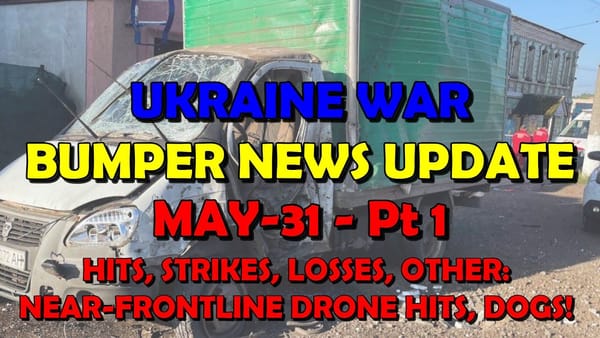Ukraine Conflict: Full Frontline Update
Table of Contents 📖
"Why would you insist on sending your troops in on foot and with only supply from golf carts and motorbikes? Why would you do that voluntarily? Well, the only reason you would do that is because you had no other option. You just don't have that depth of or that stock of mechanized equipment to do otherwise."
Hello Team
🎦 00:00-00:33⏩
Jonathan welcomes viewers to another ATP Geopolitics video, a frontline update for 31st May 2024. He acknowledges that recent videos have been rather lengthy, but there has been a significant volume of pertinent news about the situation in Ukraine. He expresses gratitude to JR for the map updates.
Return to top⤴️
📍 FRONT-LINE UPDATE -🗺️ MAP LEGEND

Preamble: Overall situation
🎦 00:33-06:38⏩
Jonathan observes that there haven't been significant changes on the front line. He's been feeling more positive over the last week: Russia appears to be struggling to launch meaningful offensives along the front line. Despite deploying 50,000 troops to Belgorod (supposedly to attack Kharkiv) and stationing 15,000 in Sumy, there are reports that Russia is redeploying troops from other front line areas to Kharkiv. Ukrainian General Staff reports that Russian forces have resumed activity near Liptsi, a strategically crucial location north of Kharkiv. Jonathan speculates that Russia's objective is to gain artillery range to target Kharkiv, but the Ukrainians have so far been successful in repelling them. The Institute for the Study of War (ISW) notes that senior Ukrainian military officials have reported on the transfer of Russian forces to northern Kharkiv from other sectors on the front line. This suggests that the Russian military is prioritising the fixing of Ukrainian troops in this region. Jonathan observes that this aligns with his previous analysis: Russia's strategy seems to involve pinning down Ukrainian forces in Kharkiv to gain an advantage. However, the redeployment of Russian troops from other areas suggests a lack of success, weakening their lines elsewhere. While Russia might be pulling troops from less critical areas, this highlights their need to reinforce Kharkiv due to their struggles there.
Return to top⤴️
Russia's logistical and economic challenges
🎦 06:38-08:52⏩
Jonathan analyses Russia's struggles to manufacture sufficient military equipment, including infantry fighting vehicles, tanks, and armoured personnel carriers (APCs). They are depleting their stockpiles across Russia, with satellite imagery suggesting they've exhausted their ancillary supply vehicle stockpiles, including bridging pontoons and armoured recovery and engineering vehicles. Jonathan lists various military equipment types - MTLBs, BMPs (various models), towed artillery such as D20s and D30s that are being depleted faster than they can be replaced. Jonathan believes Russia's reliance on stockpiles, without the production capacity to replenish them, puts them in a vulnerable position. He questions their ability to produce sufficient new tanks to offset their losses. The economic strain of the war is evident in Russia's decision to introduce a progressive income tax in 2025, likely an attempt to distribute the financial burden of the war onto Russia's wealthy elite.
Return to top⤴️
Ukraine's strategic strikes
🎦 08:52-10:26⏩
In contrast to Russia's struggles, Jonathan highlights Ukraine's successful targeting of key Russian infrastructure and assets. Their strategic strikes have hit oil depots, refineries, and port infrastructure, disrupting Russia's ability to transport supplies across the Kerch Strait. Two out of three rail ferries operating in the strait have been disabled, impacting their capacity to compensate for limitations on the Kerch Bridge. Jonathan notes Ukraine's systematic approach to degrading Russia's war-fighting capabilities, targeting airbases, supply depots, and command and control nodes. He lists some of the weapons being used: Storm Shadows, Scalps, and Neptunes (including a Neptune missile strike on oil depots near Kerch). He observes that Ukraine appears to have ample supplies of HIMARS ammunition, indicating the likelihood of continued and potentially escalated strikes, including targets within Belgorod.
Return to top⤴️
Russia's demographic crisis
🎦 10:26-12:36⏩
Jonathan transitions to discuss Russia's demographic challenges, which existed before the war but have been exacerbated by it. Putin's recent video conference with large families from various Russian regions, as part of the "Year of the Family 2024" initiative, highlights the government's concerns about declining birth rates and the need to boost population growth. The war's impact on Russia's demographic outlook is substantial, with significant male casualties further diminishing an already dwindling population. This has serious implications for the long-term health of the Russian economy. Jonathan emphasises that Russia's problems are not just short-term military setbacks but deep-rooted, systemic issues affecting their long-term demographic and economic prospects. He concludes that the combined weight of these challenges paints a bleak picture for Russia's future.
Return to top⤴️
Ukrainian forces regain ground in Vovchansk
🎦 12:36-16:52⏩
Shifting back to the front line, Jonathan reports that Ukrainian forces have regained some positions within Vovchansk, pushing back against continued Russian offensives in the area. Geolocated footage reveals house-to-house fighting in central Vovchansk, indicating the fluidity of the situation and challenging the accuracy of some maps which depict the area as under Russian control. While the situation is fluid, with both sides claiming control, the presence of Ukrainian forces within Vovchansk suggests they are making progress. Jonathan acknowledges the brutality of the fighting, with Russia using significant firepower, including UMPC guided bombs. However, he suggests that Russia's need to bring in reinforcements is indicative of Ukrainian resistance and potential setbacks for the Russians. Footage of Russian casualties in Vovchansk further supports this assessment. Jonathan also casts doubt on Russian claims of controlling areas south of the Vovcha River, citing evidence suggesting otherwise. He highlights the difficulty of maintaining control in urban areas bisected by rivers, which pose logistical challenges for both sides. Jonathan cites a report indicating that Russian troops are often reliant on foot patrols, motorcycles, and ATVs in northern Kharkiv Oblast. He interprets this as a sign that Russia lacks sufficient mechanized equipment to operate effectively in the area.
Return to top⤴️
Frontline updates: Northeastern axis and elsewhere
🎦 16:52-29:32⏩
Jonathan provides a quick update on the northeastern axis:
- Kupyansk and Svatove to Kreminna: No significant changes.
- Siversk: Quiet, with no confirmation of earlier claims that Ukraine had retaken Vesele.
- Chesivyar: Deep State Maps shows minor Russian gains in the northern part of the canal micro-district. However, Jonathan remains sceptical of predictions that Russia will capture Chesivyar, given their struggles elsewhere and the need to redeploy troops. He questions whether they can amass sufficient forces to take the town.
- Avdiivka: Limited Russian advances, with small gains around Soloviov, south of Ocheretyne, where they have been trying to advance towards Novopokrovsk. Jonathan downplays the significance of these gains. He speculates that Russia's reliance on convicts and the effectiveness of Ukrainian mobilisation will make it increasingly difficult for Russia to make further gains. He believes the optimal time for Russia to make advances has passed, and each week will become more challenging for them.
- Krasnohorivka: Static despite heavy fighting, with no significant changes in control. Jonathan dismisses Russian claims of capturing the city council building in Krasnohorivka, as the building was already under their control.
- Novomykolaivka and Marinka: Stable with no changes.
- Velyka Novosilka: Stable, which is a positive development considering Russia's recent advances in the Staromaiorske area.
- Robotyne: Minor gains by Russia inside Robotyne according to Deep State Maps. Jonathan notes discrepancies between different maps and sources, particularly the Russian Ministry of Defence (MoD), regarding the level of Russian control in Robotyne. He emphasises the importance of critically evaluating information from sources like the Russian MoD.
Jonathan then moves on to the situation in and around Krinky. He expresses uncertainty about the situation there, finding reports and maps to be unclear. The ISW reports marginal Russian advances on the left bank of the Dnipro River near Krinky, but Jonathan questions the accuracy of these reports, based on his understanding of Ukrainian positions and the use of Ukrainian FPV drones in the area. He suggests the ISW's claims of Russian gains might be misplaced, and the area could be more of a grey zone than under Russian control. Finally, he addresses the situation in the Oleshky Sands area and near Nastreya Island. He is unable to geolocate reports of Russian assaults in the area, finding inconsistencies in the information provided. Jonathan concludes his frontline update with a general assessment that Russia has failed to achieve significant momentum. He speculates that the loss of six Russian planes in May, potentially due to Ukrainian air defences, might have contributed to Russia's reduced use of guided bombs, particularly on the Avdiivka front. Jonathan wonders if this loss of air support has played a role in stalling Russia's advance in the region and speculates about the potential impact of increased Ukrainian air defence capabilities in Kharkiv, possibly leading to further Russian aircraft losses.
Return to top⤴️
Wrap up
🎦 29:32-30:53⏩
Jonathan concludes by reiterating that, despite earlier concerns, Russia has not gained the momentum many feared. He wonders if this might be linked to the losses they've suffered, including the six planes downed in May, which may have impacted their ability to provide air support to their troops. He questions what this means for the situation in Kharkiv, where Russia has been utilising its air force heavily. He speculates that if Ukraine were to deploy more advanced air defences in the region, it could lead to further Russian aircraft losses, potentially turning the tide in favour of the Ukrainians. He invites viewers to share their thoughts on his assessment and signs off.
Return to top⤴️



